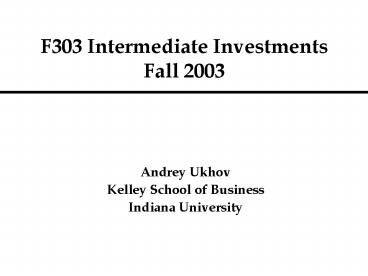F303 Intermediate Investments Fall 2003 - PowerPoint PPT Presentation
1 / 22
Title:
F303 Intermediate Investments Fall 2003
Description:
Dow Jones: 1900 - 2002. Dow Jones: 1980 - 2002. The UK Market: 1900-2002. Dow Jones' Annual Returns (1945-2002) US, Japan and UK Markets: Annual Returns (1976-2002) ... – PowerPoint PPT presentation
Number of Views:71
Avg rating:3.0/5.0
Title: F303 Intermediate Investments Fall 2003
1
F303 Intermediate InvestmentsFall 2003
- Andrey Ukhov
- Kelley School of Business
- Indiana University
2
F303 Intermediate InvestmentsFall 2003
- Andrey Ukhov
- Room BU356B
- E-mail aukhov_at_indiana.edu
- Office Hours Monday 200-400
- and Thursday 400-600.
- Alternatively, by appointment only
3
What is This Course About?
- Risk and returns of different financial
instruments - Diversification and how it reduces portfolio risk
- Asset pricing models and implications to
investors - Examining the performance of fund managers
- Bonds yield-to-maturity and meaning to the
investing community - Derivative instruments and payoffs associated
with various option positions
4
Investment Environment and Investment Process
- Investment Environment refers to the different
types of marketable securities available for
investors - Investment Process is about the way investors
should decide on the marketable instruments they
will invest in, when to invest, etc.
5
Marketable Financial Securities
- Financial Instruments
- Direct Investments Indirect Investments
- Money Market Instruments Capital Market
Instruments Derivative Instruments - Fixed Income Instruments Equity Instruments
6
Markets Founding Dates For World Equity Markets
7
How Can We Define Investments?
- Investment can be defined as the sacrifice of
present consumption for some future value. This
future value is possibly uncertain - Three main sectors to consider households,
business, and government. - The first sector has to decide on investing
funds the last two need to raise funds.
8
Risk and Return
- Understanding the tradeoff between risk and
return. - What does this mean?
- When investments are compared, risk and expected
return go with each other. - Why is the trade-off important?
- Because we believe that investors are
risk-aversehence they have to be compensated for
the risks they take.
9
Historical Analysis of Risk and Returns
- So how can we go about making investment
decisions? - One avenue is looking at historical analysis.
- Such an analysis gives support to the view that
there is a positive relation between risk and
reward.
10
Dow Jones 1900 - 2002
11
Dow Jones 1980 - 2002
12
The UK Market 1900-2002
13
Dow Jones Annual Returns(1945-2002)
14
US, Japan and UK Markets Annual Returns
(1976-2002)
15
U.S. Treasury Bills Annual Returns (1945-2002)
16
Risk-Return Relationship for Different
Instruments (1928-2000)
17
Risk-Return and Diversification
- Common Stock
- Return 13.5 Risk 22
- Corporate Bonds
- Return 5.5 Risk 7
- Common Stock (50) and Bond (50) Blend Portfolio
- Return 9.5 Risk 11.60
18
Risk-Return and Diversification
- Building a portfolio with 50 Common Stock and
50 Corporate Bonds produces an interesting
result - portfolio returns are the weighted average of
both Common Stock and Corporate Bonds - but portfolio risk is LESS than the weighted
average of the risk of individual asset classes!!
19
Historical Variability and Prospective Risk
- Historical variability is not necessarily an
indication of prospective risk. - The former deals with the record over some past
period the latter has to do with uncertainty
about the future. - However, historical variability can be one very
useful tool to analyze returns on common stock.
20
Can We Obtain the Best Investment?
- Very difficult to make general conclusions
- Why?
- The optimal investment depends on the investors
preferences - ...his/her distates for risk are crucial and have
to be analysed very carefully!
21
For Next Session
- We shall discuss risk and return in more detail
- Review the basic statistics that we will use in
order to measure and understand risk and return - Introduce the mean-variance framework.
22
Key Points to Remember
- Investment Environment and Investment Process
- Investment is the sacrifice of current for future
dollars - We have to consider return and risk
- Historical analysis shows that equity produces
high but variable returns while fixed income
securities generate lower but less variable
returns.































